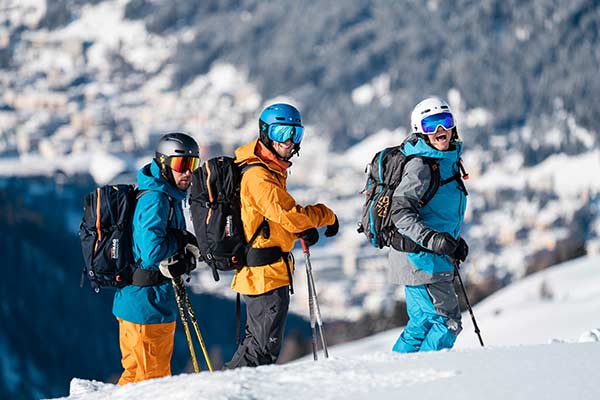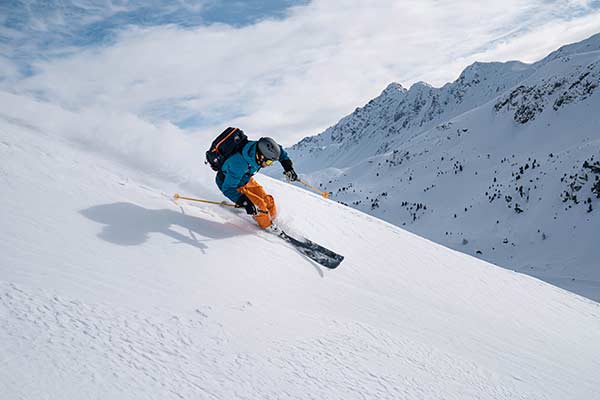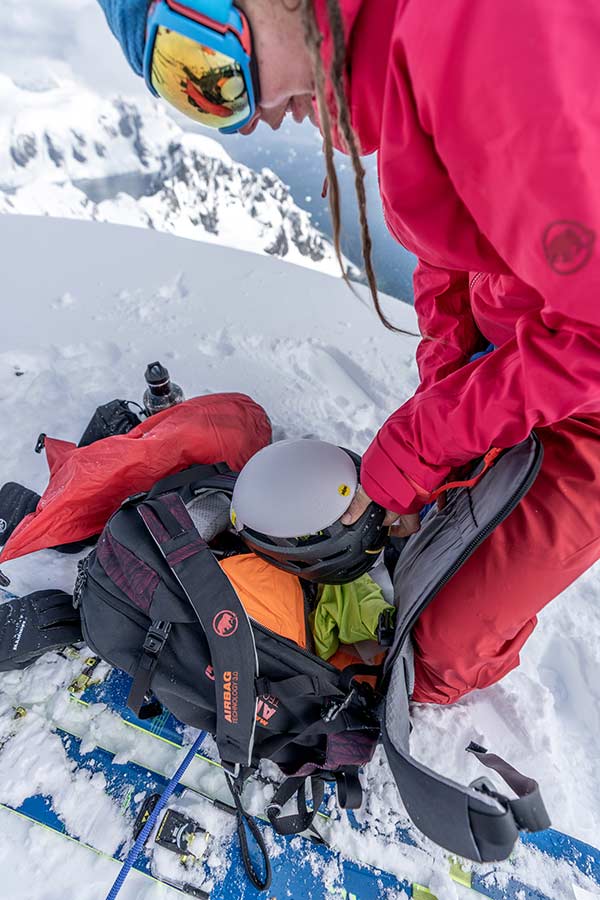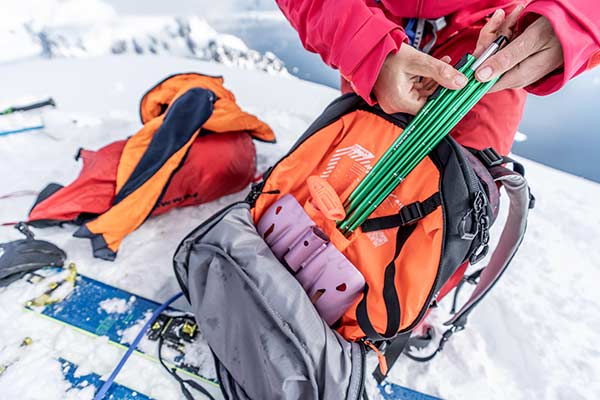In 1985, ABS launched the first avalanche airbag backpack. Today, the self-rescue system is part of the obligatory emergency equipment for many winter sports enthusiasts. At Bächli-Bergsport, customers can choose between five different airbag systems. How they work and what advantages each system brings: an overview.
A contribution by Rabea Zühlke – Bächli Bergsport
Bright blue sky, an untracked slope, the first enjoyable turns in the snow. Then it happens: the slope breaks, thousands of tons of snow begin to rush down the valley at frightening speed. A strong pull, a bang, and three seconds later the greatest hope is air – or rather, a balloon filled with compressed air.
Avalanche airbag backpacks are the only emergency equipment that can prevent burial in an avalanche. The physical principle behind it is called inverse segregation, popularly known as the Brazil nut effect. In a moving mass of particles, smaller particles orient themselves downwards, larger ones upwards.
For example, if you shake a muesli glass, Brazil nuts will automatically move to the top and oatmeal to the bottom. The same principle applies to a person with an inflated airbag in an avalanche: the avalanche victim “swims” on the surface due to the buoyancy.

However, only in the ideal case. In 2014, avalanche researcher Pascal Haegeli and a team of experts investigated to what extent an avalanche airbag actually increases the probability of surviving in an avalanche: In the research they analyzed more than 245 avalanche accidents in which people with and without airbags were involved in the same avalanche.
The result: 22,2 percent of all people who get caught in an avalanche without an airbag die. With the airbag inflated, the figure is 11,1 percent. An inflated airbag can therefore prevent half of the fatalities. At the same time, it means that even with an inflated airbag, every ninth buried person still dies.
The difference is significant, but not as big as previously assumed. In addition, the optimal case was considered, i.e. the person was able to deploy the airbag. In practice, however, every fifth avalanche victim fails to deploy the airbag.
The avalanche airbag backpack
Nevertheless, the avalanche airbag backpack is useful emergency equipment that can save lives. Release should be trained, the backpack regularly serviced and the avalanche transceiver equipment should not be neglected - just like tour planning. If you take all these factors into account, the airbag is a safety plus.
Put simply, each model consists of a release unit, usually in the form of a handle that can be stowed in the shoulder strap, a filling unit, which is usually located in the middle part of the backpack, and an air cushion, which is compressed in a separate, protected compartment in the upper part of the backpack.
In addition, every avalanche airbag backpack has a leg loop that is threaded through from the back between the legs to the front and hooked into the hip belt. This leg loop, often seen as an unnecessary feature, prevents the avalanche from tearing the backpack from your body.
In general, all avalanche airbag backpacks approved in Europe have had to meet an EU standard since 2017, which stipulates, for example, a minimum volume of the air bag of 150 liters.
volume and buoyancy
With its patented TwinBag, ABS offers two 85-liter airbags that are completely separate from each other. They should provide more lift than a mono airbag and also serve as a reserve if an air cushion is damaged. In addition, the airbags are tailored to the body's center of gravity.
"The position and volume of the airbag are much more important than the number," explains Ski & Mountain merchandiser Loïc Tonnot from Black Diamond Europe. Black Diamond's JetForce Pro 35 airbag therefore has a volume of 200 liters.
Avalanche airbag backpacks with a volume of at least 25 liters are suitable for day tours, while 35 to 45 liters make sense for high alpine tours or ski traverses. With some manufacturers, such as Mammut, Alpride or Ortovox, the airbag systems can be completely removed from the backpack and reinstalled in models with a smaller or larger volume.
Backpacks from ABS or Black Diamond, on the other hand, have a modular structure: A small backpack with an airbag system forms the basis and can be expanded with zip-on lid pockets and attachments.
«Freeriders often choose a zip-on version, while tourers have a need for a simple, but somewhat lighter airbag backpack.»
Matthias Schmid, Bächli product manager
Features such as a height-adjustable handle, conversion for left and right-handed users and test releases are now standard equipment.

Different principles
Bowden cable, pyrotechnic triggering or a supercapacitor? What sounds like a lot of technical know-how is actually not that complicated. Avalanche airbag systems fall into two categories: mechanical and electronic systems.
The most important differences first: Mechanical systems with an extra-light carbon cartridge weigh around 1000 grams. With a backpack, they cost around CHF 600 to 700, the carbon cartridge around CHF 160. The purchase prices for electronic airbag backpacks, which are filled via an electronically controlled blower, are around CHF 1000 and weigh around 1300 grams.
mechanical systems
The cartridge systems are all based on a similar principle: Like a bicycle brake, they are triggered via a Bowden cable that connects the airbag to the cartridge. “If you pull the release handle, a cable is pulled, which in turn releases a spring. A spring-driven needle finally pierces the gas cartridge, the gas escapes and fills the air cushion,” summarizes Alexander Weijnman, Head of Avalanche Safety at Mammut.
It takes three seconds for the nitrogen compressed at 300 bar (and completely harmless for the user) to unfold and completely inflate the airbag. In addition, ambient air is sucked in via nozzles in order to fill the airbag together with the gas.
“The advantage of mechanical systems is the high initial energy: a certain amount of force is required to get the airbag out of the backpack. This is higher with cartridge systems than with electronic ones, which is why the airbags can be packed together in a very compressed manner.”
Alexander Weijnman, Head of Avalanche Safety at Mammut

The systems with gas cartridges also include the RAS from Mammut and the Avabag from Ortovox. Both manufacturers have developed their own system, but the principle behind it is the same - the weight of the carbon cartridges at 310 grams is also the same.
It is important for the user that the spring of the release system has to be tensioned again after each (test) release. How this works can be read in the instructions for use. Only with the Mammut systems is the spring tensioned automatically when the cartridge is screwed in.
Pyrotechnic trigger
The Munich company ABS uses a different triggering system: With pyrotechnical triggering, the handle contains an explosive device that triggers a tiny explosion when pulled. A metal pin, pushed by the explosive device, eventually pierces the bottle's seal and the gas escapes. After a deployment, not only the cartridge but also the handle must be replaced.
"The construction is still considered to be extremely reliable, but systems with a Bowden cable have proven to be on a par over the years."
Matthias Schmid, Bächli product manager
Repeated (test) releases are not possible with cartridge systems. After a deployment, the cartridge must be replaced with a new one or refilled. "The replacement is possible in every Bächli branch and costs between CHF 10 and CHF 29, depending on the airbag system," says Matthias Schmid.
A test deployment when purchasing an avalanche airbag is free in the Bächli branches - so users can get to know the deployment system directly.
At around 300 grams (300 bar/0.68 psi), carbon cartridges weigh almost half that of steel or aluminum cartridges. However, filled cartridges can become problematic when traveling by air: airbag pressure cartridges are generally covered by a special regulation of the IATA (International Air Transport Association), but it is still advisable to consult the respective airline before departure. Some manufacturers therefore offer empty steel or aluminum cartridges for sale, which can be filled in local diving shops, for example.
"But it is also advisable to clarify the current rules for electronic systems: The Black Diamond Jetforce, for example, has a large battery installed, and some airlines are still unfamiliar with Alpride capacitors."
Matthias Schmid, Bächli product manager
Various airbag systems: the overview
| system/manufacturer | system weight | airbag volume | Gas/Filling | refilling | Price |
|---|---|---|---|---|---|
| mechanical systems | |||||
| Avabag (Ortovox) | 690 g (without cartridge) | 160 liters | Nitrogen | CHF 29.- (exchange at Bächli) | From CHF 719.- (Ascent 22 Airbag) |
| RAS Removable Airbag System (Mammut) | 700 g (without cartridge) | 150 liters | Nitrogen | CHF 10.- (exchange at Bächli) | From CHF 629.- (Flip Removable Airbag 3.0 22) |
| ABS Twinbag system (pyrotechnic release system, ABS) | 1390 g (without cartridge and handle) | 170 liters (2×85 liters) | Nitrogen | CHF 24.- (exchange of the cartridge and cartridge at Bächli) | From CHF 719.- (A. LIGHT Tour S) |
| Electronic systems | |||||
| Alpride E1 | 1280 g | 150 liters | Condenser with radial fan | Capacitor charging (with two AA batteries or micro USB) | From CHF 989.- (Scott Patrol E1 22) |
| Jetforce Pro (Black Diamond) | 1250 g | 200 liters | Lithium-ion battery with jet fan (57.6 Wh) | Charging the battery (current) | From CHF 1199.- (JetForce Pro 35) |
Fully electronic systems
The electronic release units do not require any gas cartridges at all. In 2014, Black Diamond and Pieps brought the first fully electronic avalanche airbag backpack onto the market with the Jetforce system, four years later another electronic system was presented with the Alpride E1. Arc'teryx also entered the market in 2016 with the Voltair, but then quickly disappeared again from the European market: the backpack had not received a TÜV in Europe.
The JetForce Pro system is powered by a rechargeable lithium-ion battery. After deployment, a fan refills the airbag at regular intervals. "This means that even a damaged air cushion with a fist-sized hole remains inflated," explains Loïc Tonnot from Black Diamond Europe.
At the same time, the blower ensures that the airbag is deflated after three minutes, creating a 200-litre breathing cavity for the victim.

In addition, the electronics carry out an automatic function test of the system each time it is started up, and the system status is displayed via LEDs on the handle. In the Alpride E1 system, the conventional lithium battery technology has been replaced by a supercapacitor: This stores enough energy for two activations regardless of the weather and can be recharged in 40 minutes using a micro USB cable or two AA batteries.
“The airbag can be deployed several times for training, and multiple deployments are also possible on one tour. A situation in which this is necessary should of course not be provoked," warns product manager Matthias Schmid.
"The advantage of multiple deployments is that you can deploy the airbag more quickly when in doubt and there is less risk of missing the right moment to deploy."
Matthias Schmid, Bächli product manager
What is the future?
"The systems with print cartridges are already very mature, but there is probably still some potential with the electronic ones," estimates Matthias Schmid. "It could well be that at some point a new system will outshine all the others - but the differences will no longer be so great that current models will have to be replaced."
This post originally appeared in the Issue 1/22 of the inspiration magazine from Bächli Bergsport.
That might interest you
- Everything under control: Four types of gloves for cold days
- Hybrid jackets: The alternative to the layering principle
- Thanks to this planning, your ski tour will be a success
About Bächli mountain sports
Bächli mountain sports is the leading Swiss specialist shop for climbing, mountaineering, expeditions, hiking, ski touring and snowshoeing. At currently 13 locations in Switzerland, Bächli Bergsport offers its customers expert advice and high-quality service. Published on LACRUX Bächli mountain sports periodically exciting contributions to the topics climbing, bouldering and mountaineering.
+ + +
Credits: Cover picture and article pictures: Bächli mountain sports

